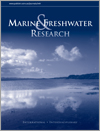Marine and Freshwater Research
Volume 73
Number 7 2022
This study observed the food-based competition at 26°C between juvenile specimens of two crayfish species found within the Lake Eyre Basin, Australia, the invasive red-claw crayfish (Cherax quadricarinatus) and the native blue-claw crayfish (Cherax destructor). The results of this study indicated that red-claw crayfish is highly aggressive, whereas blue-claw crayfish has much more submissive tendencies. This dynamic between the species is concerning and could lead to blue-claw crayfish being displaced from the Lake Eyre Basin.
DNA sequences are used to investigate the relationships of marine gastropods (including Bembicium flavescens, Cellana howensis and Tenguella marginalba) from Lord Howe Island. Most species show genetic connections with tropical landmasses, but T. marginalba (closely) and B. flavescens (more distantly) have connections to temperate mainland Australia. Genetic divergence within Lord Howe Island populations apparently dates from long after island formation.
Aquatic mites are diverse and often abundant in freshwater environments. They are often difficult to identify and can benefit from the use of DNA methods to assist in distinguishing species. Our study contributes new DNA barcodes from 17 genera to identify water mites from Australia and which can be used to improve their identification when monitoring biodiversity in freshwater environments.
Understanding the ecosystem around subsea oil and gas infrastructure is imperative to decommissioning. Our study found differences in fish assemblage data derived from industry remotely operated vehicle (ROV) video and baited remote underwater video (BRUV) collected along a subsea pipeline. Both methods sampled the same number of species, but ROV sampled more site attached species compared to BRUV.
Litterfall input is an important ecosystem process for small forest streams. Hovenia dulcis Thunb. is a non-native, invasive species in Brazil. Here, we observed that the presence of H. dulcis in the riparian vegetation altered the temporal pattern of litterfall inputs to a subtropical stream, with higher inputs from H. dulcis, especially leaves and reproductive parts, in autumn.
A balanced survey design and baited camera systems were used to monitor the abundance and diversity of finfish in the inner Queen Charlotte Sound, New Zealand. With seasonal observations conducted over 3 years, study outputs provide the first quantification of finfish relative abundance and biodiversity in this highly valued marine environment.
Experiments in south-eastern Queensland found that the mudflat community was unresponsive to increased densities of native crabs and whelks; the assemblage simply absorbed the four-fold increases in their abundance. A deeper redox layer and elevated organic matter content were also observed. Results suggest that these systems may have the capacity to support enhanced macrofaunal biomasses and ecosystem service delivery.
Invasive common carp are difficult to eradicate so management often entails reducing their population to a level that helps restore one or more components of the aquatic ecosystem. We conducted an enclosure experiment in a small wetland to determine the threshold biomass for carp at which water clarity, nutrients, and submerged aquatic vegetation would, or would not, be affected by carp.





